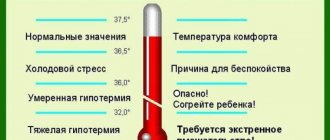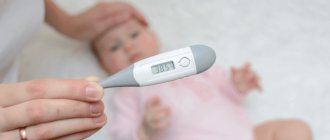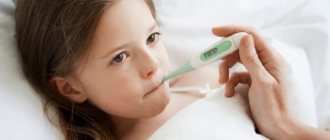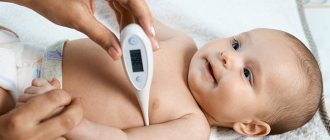Every mother has probably experienced a situation when her child’s temperature does not go down. The baby becomes red and hot, sweats profusely and cries loudly. It’s not immediately clear what to do? Should I take out a thermometer or not waste time and call an ambulance? In this article you will find answers to these and other pressing questions.
Maksimenko Alexey Vladimirovich
pediatrician, family doctor
If paracetamol or ibuprofen does not help reduce your child's fever, you should take him to a doctor. Children under 3 years of age with a temperature of 38.5°C should urgently call emergency services or an ambulance.
You may be interested in: Cancer prevention in children: 10 important steps 10 rules for healthy children's sleep
Causes of elevated temperature in a child
All children get fever from time to time and it’s not scary. In most cases, after a few days the child makes a full recovery and feels great.
Body temperature is rarely static. It can change several times a day: it decreases in the morning and increases in the evening, it will change during physical activity, etc. But strong jumps are the body’s response to an infection. In this way, the body tries to fight viruses, bacteria and other pathogens, creating an unfavorable environment for them.
It is important to remember that a child’s temperature itself is not a disease, but a symptom. And there are several possible reasons for it:
- infection - of varying complexity (from colds to meningitis);
- reaction to the environment - in newborns and young children, the temperature may rise due to hypothermia or overheating, since their body does not yet regulate heat as well as in older age;
- childhood vaccinations – fever may be a side effect of vaccination;
- Teething – As a rule, when a baby is teething, the temperature does not rise above 37.8°C. If the thermometer readings are higher, the problem is not in the teeth.
You may be interested in: Flu vaccines 2016-2017: names and prices
For what reasons is it sometimes difficult to bring down a high temperature?
It happens that even the effective measures listed do not give the desired result. The temperature either does not decrease, the face rolls back a little under the influence of medications, but quickly returns to the figure of 39ºC. This may be due to the following reasons:
- The disease is based on the activity of bacteria or the presence of purulent tissue inflammation.
- The pathology is provoked by a specific virus (rotavirus, the causative agent of infectious mononucleosis).
- Fever is caused by inflammation of the meninges or brain (meningitis, encephalitis). In this case, symptoms characteristic of the condition are noted: vomiting, headaches, impaired consciousness, convulsions).
- The infection is reinforced by a metabolic disorder caused by an endocrine disease (for example, problems with the thyroid gland).
In some cases, the high temperature does not decrease only because the child is wrapped up too carefully and the body has nowhere to give off heat.
How to measure temperature in children of different ages
You can suspect a high temperature using your hand or a kiss on the forehead, but the method is not very effective. More specific data is needed.
Fever is indicated by the following thermometer readings:
- temperature in the mouth – 37.5°C;
- rectal temperature – 38°C;
- armpit temperature – 37.2°C.
But even this does not answer the question of what exactly the baby is sick with. For example, a cold can also cause a fairly high temperature (38.9-40°C), while serious infections, especially in young children, can occur with a normal or low temperature (below 36.1°C). Therefore, it is worth paying attention not only to temperature, but also to other signs: breathing rate, behavior, etc.
You might be interested in: What does a temperature of 37.3 mean?
Which thermometer to use
For children under 3 months of age, the most reliable way to measure temperature is with a digital rectal thermometer.
For babies 3 to 6 months old, a digital rectal thermometer is still the best option, and a temporal artery thermometer can also be used.
For children aged 6 months to 4 years, it is recommended to use an oral thermometer, temporal artery thermometer, or electronic ear thermometer. You can also use a thermometer to measure your axillary temperature, but this method is less accurate.
For children 4 years and older, any thermometer can be used.
Whichever method you choose, keep the following in mind:
- do not take your temperature after taking a bath;
- When measuring temperature, never leave your child unattended;
- do not use oral thermometers;
- do not rush to lower the temperature (to 38°C) if the child’s condition is stable (there are no signs of difficult breathing, seizures at fever, prolonged crying, etc.).
You may be interested in: Reducing high body temperature in children
When to give medicine
Doctors believe that at temperatures up to 38 or 38.5 degrees, there is no need to give antipyretic drugs. This is due to the work of the immune system to produce antibodies to viruses and bacteria. In case of sudden hypothermia or a stressful situation, the immune system weakens, and at this time microbes and viruses begin to actively multiply. It is the activity of microorganisms that causes inflammation and the formation of pus.
However, if the temperature begins to rise significantly, this indicates a weak immune system - it is not able to cope with the activity of microorganisms. The immune system creates unfavorable conditions for bacteria to survive by raising the temperature, but sometimes this is not enough. If you see that the thermometer is steadily rising, you need to lower your child’s temperature. If this is not done, severe dehydration may occur, as well as other pathological processes.
If your baby has previously had febrile convulsions due to hyperthermia, you should not wait until the thermometer reaches 38 degrees: for such children, the temperature is reduced already at 37 degrees. This is due to the body's intolerance to fever. Immediate reduction of fever in a child is also necessary for neurological diseases and pathologies of internal organs.
It is also necessary to bring down a child’s temperature if he has a severe illness, which is accompanied by chills and muscle pain. In this case, the baby looks very bad, weakens, cries, and sometimes he may appear blue or pale. Give the medicine immediately and call the doctor.
What medicine should I give my baby?
Now let's look at the question of how to reduce the temperature of one-year-old children. The age of the baby is important: infants cannot take pills, unlike children of 5 years old. Therefore, manufacturers have developed special antipyretic mixtures and syrups that can quickly eliminate fever in the body. These include syrups and suppositories based on ibuprofen and paracetamol: only these two medications and their derivatives are allowed for children.
How to bring down the temperature if the baby is vomiting and nausea? In this case, the syrup will not help - you need to use rectal suppositories. If a child has diarrhea, you can lower the temperature with the help of syrups. In these cases, the baby is at risk of dehydration due to rapid loss of fluid, so offer the child water more often. If he refuses to drink from a pacifier or cup, feed him from a spoon every 10 minutes.
When fever is a dangerous symptom
Previously, a high fever was enough to warrant treatment. But now doctors have slightly adjusted their tactics and believe that medications are not needed for a temperature of 38.9°C. However, there is one important exception: In infants under 3 months of age, a temperature of 38°C or higher is enough to warrant immediate emergency room visits.
If the high temperature lasts more than 24 hours (in children under 2 years of age) or 72 hours (in children 2 years of age and older), you need to call an ambulance.
It is not necessary to call an ambulance for older children if:
- the child is still interested in the game;
- eats and drinks well;
- has normal skin color;
- after some time the temperature decreases;
- if the child’s fever does not decrease, rises above 38°C or causes discomfort to the child, you can bring it down with paracetamol or ibuprofen (for young children it is recommended to use these drugs in the form of syrup - Efferalgan, Nurofen for children, Paracetamol for children).
Important! Children under 2 months should not be given antipyretics without a doctor's recommendation.
You may also be interested in: How to protect children from unnecessary antibiotics
We bring the temperature down from 39°C
There are only two substances approved for the relief of hyperthermic syndrome in children: Paracetamol and Ibuprofen. They are available in the form of syrups, suspensions, and rectal suppositories. It's good if they helped from the first use. If a child’s temperature of 39°C or higher cannot be brought down, other measures must be taken:
- Repeat taking the antipyretic drug, but with a different active ingredient. If the baby first took a drug based on ibuprofen, then after an hour if there is no effect, you can give a drug based on paracetamol.
- If the fever remains at 39 after an hour, you can use the Analdim rectal suppository for children. You need to check the dosage at the pharmacy. The suppository combines analgin and diphenhydramine - substances that are administered intramuscularly by an ambulance doctor for hyperthermic syndrome.
- If a child has “red” fever, he needs to be unwrapped, undressed, given drinks often and in small doses, the room ventilated and the room temperature monitored (should be 18 - 21°C). You can even rinse your baby with warm water without wiping off the moisture with a towel. That is, to maximize heat transfer so that the body does not overheat and the temperature does not rise even more. Call a doctor at home.
- With “white” fever, the child needs to be warmed, dressed and wrapped in a thin blanket, and given a warm drink. To relieve vascular spasm, you should give your baby No-shpu (1/4 - ½ tablet). Call a doctor.
- If the temperature still persists or the child, despite all the actions, remains lethargic and apathetic, if convulsions and delirium occur, an acute reaction to light, sound and touch, severe general pallor and cyanosis of the nasolabial triangle, you should urgently call an ambulance.
In the case where the drugs are effective, but last too short a time (3 - 4 hours), you can change the drugs. At the first dose - ibuprofen, after 4 hours - paracetamol, after another 4-5 hours - a suppository.
Read about what to do if your child often gets colds here.
If your child has a temperature of 39°C or higher, and you cannot lower it yourself, do not be afraid to call “03”. Ambulance staff can send a team or provide advice over the phone. Do not give your child other medications to reduce fever. For example, aspirin is prohibited for use in children; it thins the blood and can cause bleeding. Don't forget: you are responsible for the health of your baby.
What to do if your child’s temperature does not go down
There are times when a child’s temperature does not go down. Pediatrician and family doctor Alexey Vladimirovich Maksimenko told us what to do in such cases.
– If paracetamol or ibuprofen (in age-appropriate dosages) do not help reduce a child’s high fever, it is necessary to show him or her to a doctor. Children under 3 years of age with a temperature that remains at 38.5°C or higher should urgently call emergency services or an ambulance.
While the team is driving, wipe the child with water at the same temperature that he currently has. If there is no vomiting, give plenty of fluids. If the temperature drops below 38°C, you still need to see a doctor, but you can wait a few hours for the local doctor.
If a child has cold hands and feet at a high temperature, you can give No-Spa in age-appropriate dosages and wear warm socks. The temperature in the room should not be higher than 22°C. Regularly ventilate the room and humidify the air. Don’t wrap your baby up, take off his diaper.
If there were no allergies before, children after 2 years of age can be given diluted lemon juice or raspberry tea.
If for some reason the doctor cannot get to you, and the child’s temperature persistently creeps up and reaches above 39.5, convulsions may begin (in some children even at lower numbers). In this case, do not cut off the telephone numbers of all ministries and administrations, but dress the child warmly and urgently take him to any nearest children's medical facility.
You may be interested: The Ministry of Health of Ukraine does not recommend taking medications for colds
Is it necessary to lower the temperature?
First of all, you need to pay attention to the child’s well-being. If he is pale, apathetic, lying down, it is difficult to make contact, his hands and feet are cold, and his lips are blue, urgently bring down the temperature, without waiting for it to rise above 38°C. This is “white” fever, which signals that the baby’s body cannot cope.
At 38°C, the temperature is reduced for children under 2 months of age, as well as for those with a history of seizures, diseases of the nervous system, blood vessels and heart, metabolic disorders and severe lethargy.
If the child has pink cheeks, hot arms and legs, he plays, actively communicates, then at a temperature of up to 38.5°C, there is no need to knock it down. This is a “red” fever, in which the body actively fights without disrupting any functions.
At 39°C, the baby’s temperature must be lowered!











